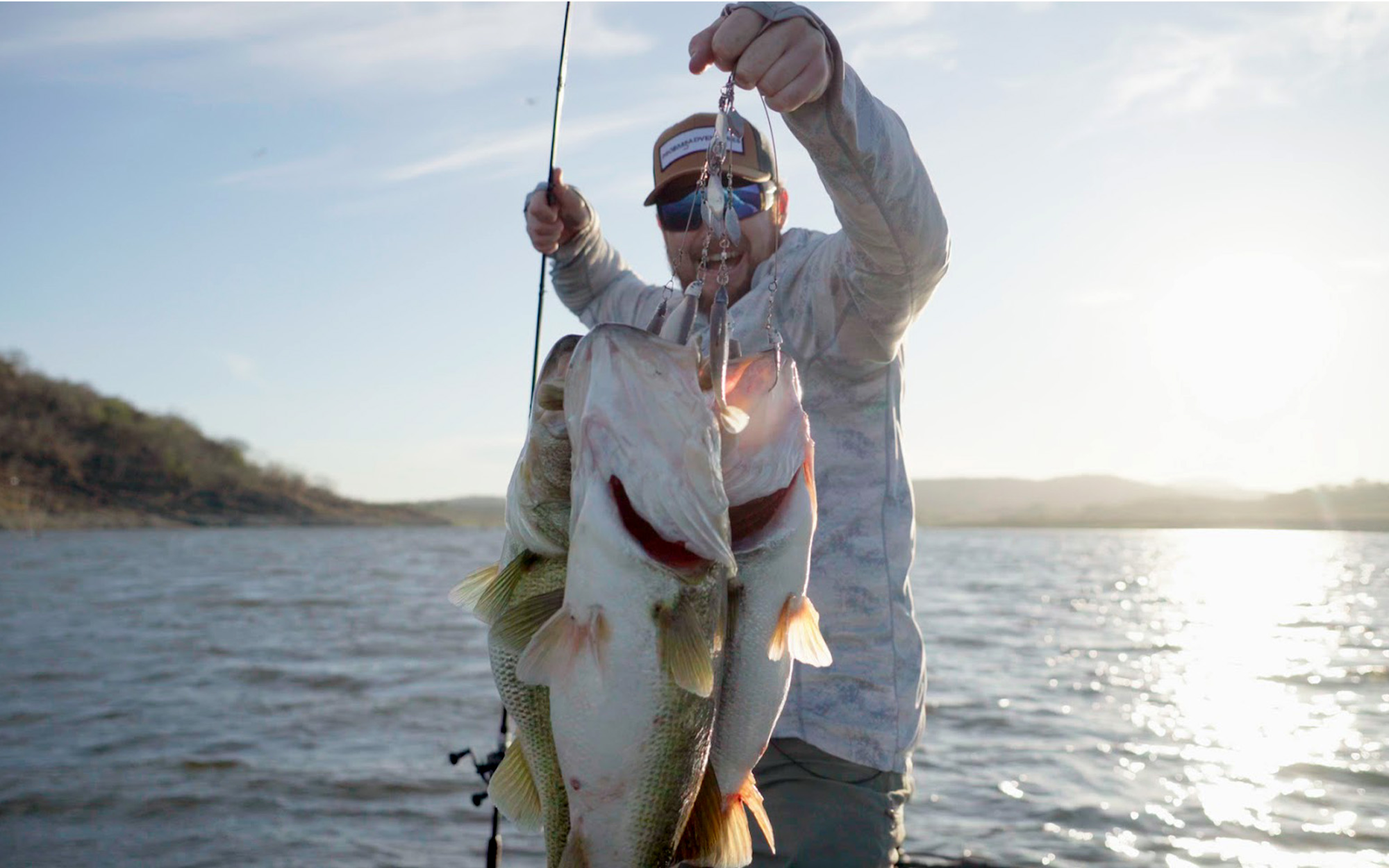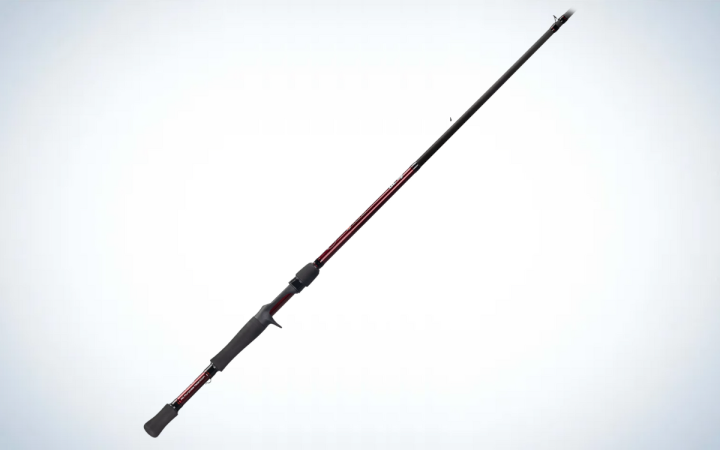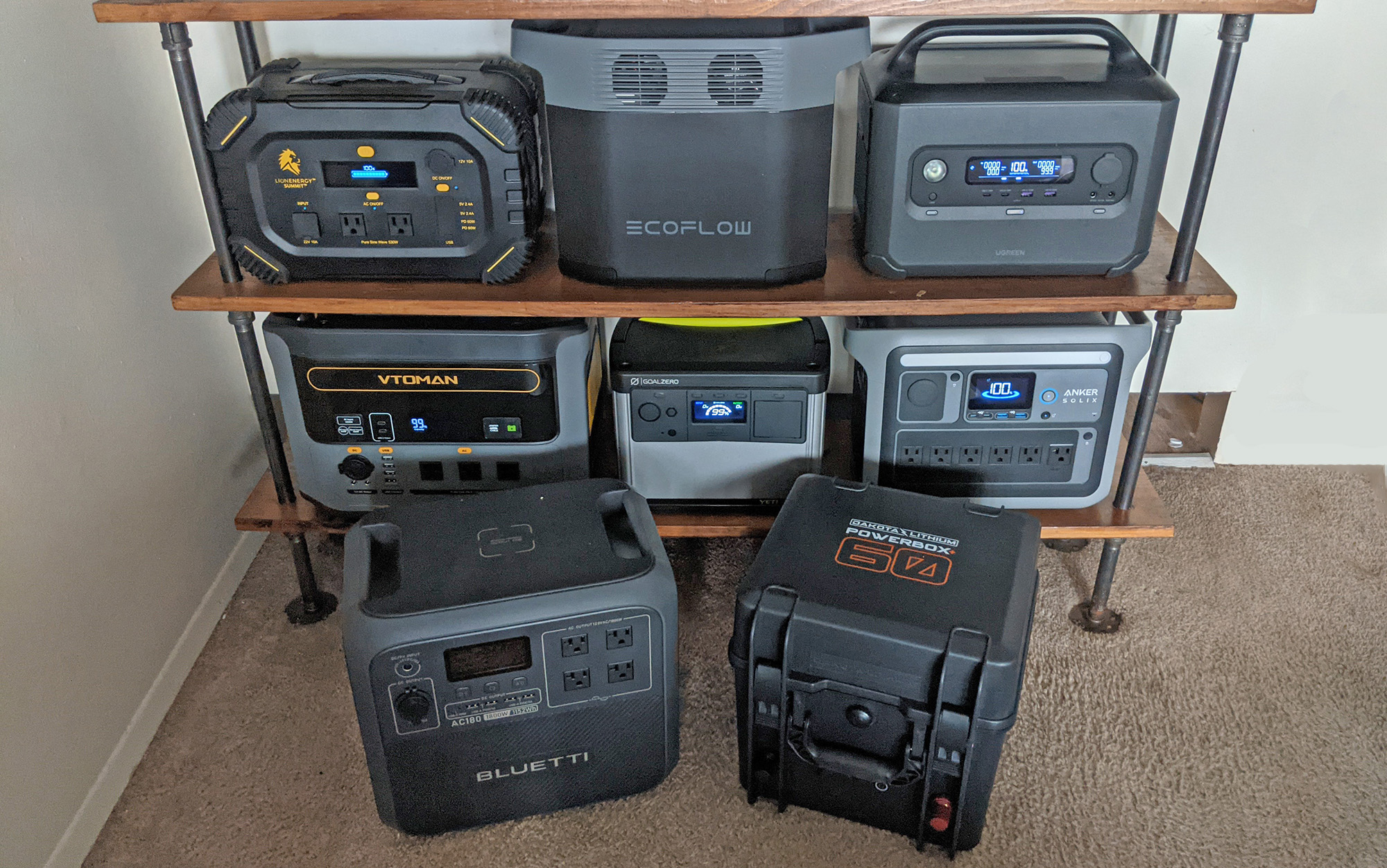How to Fish an Alabama Rig: A Complete Guide

The Alabama rig is one of the most controversial rigs in bass fishing. When anglers first started throwing it in tournaments, they dominated the competition. However, within just a few years the FLW and Bassmaster professional tours fully banned the use of the A-rig in tournaments, claiming an unfair advantage and various issues with state regulations.
The A-rig might give anglers an unfair advantage in tournaments, but recreational anglers can harness that advantage to catch giant pre-spawn bass.
Whether you’re fishing close to the bank with a lighter version, or bombing the A-rig out deep around schools of baitfish, there’s no denying the power it has to grab a bass’s attention and trick them into biting. But, it’s not as easy as just throwing some swimbaits on the wires and tossing it out there. Here’s everything you need to know about how to fish an Alabama rig.
The Alabama Rig
An Alabama rig simulates an entire school of baitfish by bringing five or more swimbaits together in one seamless rig. The standard Alabama rig consists of five bendable wires connected to a weight. There are plenty of variations offering more wires for more baits, but for those just starting out, I suggest sticking to five wires.
Attached to the end of each of the bendable wires is a snap swivel, allowing you to thread on a jig head adorned with your favorite soft plastic swimbait. Once you’ve repeated that process with all of the wires, you’re left with a rig that resembles a chandelier, but rather than crystals dangling down, you’ve got a school of baitfish.
Most A-rigs come with willow blades attached to each of the wires as well for added flair and pulling power. Once you’ve got this monstrosity of a rig in the water, however, you’ll see just how closely it resembles a school of shad, alewives, or shiners. While it can be tiring to chuck around a 2 ounce rig, the bass can’t resist it, so it’s worth the sore arms at the end of the day.
How to Rig an Alabama Rig
Depending on which A-rig design you choose, it should take no more than five minutes to be ready to fish. Some rigs might take even less time, depending on how easily you can attach your jig heads.
Step 1: Remove your A-rig from the packaging and bend out the wires so they’re near a 45-degree angle. You can always change the angle for a tighter or wider school depending on your needs.
Step 2: Thread your jig heads to the snap swivel at the end of each wire. Depending on what depth you want your A-rig to run, select the jig head size accordingly. Typically ⅛ ounce or ¼ ounce jigheads are what most anglers reach for. A quick tip is to run three of the same size jig heads on the top two wires and center wire, and two that are just a tad heavier on the bottom two wires. This will help keep the A-rig ‘upright’ as you reel it back to the boat.
Step 3: Thread on your soft plastic swimbaits. By using a drop of super glue at the head of the jig, you can ensure that the swimbait won’t slide down the hook, causing an unnatural look.
Step 4: Using a Palomar knot or shark knot, tie your line to the head of the rig.
What Makes the Alabama Rig so Effective?
Even though the A-rig might look like a hunk of metal and lead to the untrained eye, it’s a fish catching machine. The reason why is purely due to how natural it looks in the water. If you’ve ever come across a small school of baitfish in the shallows and watched how they move together, there’s always a main body of fish and few stragglers pulling up the rear.
The design of the A-rig mimics this beautifully, and by throwing in some willow blades to replicate even more baitfish in the middle of the rig, it truly looks almost identical to a bait ball as you work it through the water.
To add even more life to the A-rig, you can pump your reel during the retrieve, similar to how you’d work a glide bait, which adds a flaring action to the school that signals to nearby bass the school is about to spook, triggering a bite.
In the pre-spawn especially, baitfish tend to push shallower in the water column in search of microinvertebrates to feed on, along with warmer water to call home. As these schools of bait reach their destination, they often find themselves at a disadvantage in the open water with predatory fish lurking. After a few swipes from the bass, the big school will break up into smaller schools trying to escape, which is where your A-rig shines. While it might not look like it at first, the Alabama rig is a deadly combination of realism and hooks just waiting for a hungry bass to key in on it.
For a deep dive video on the Alabama rig, check out this great video from my friend TylersReelFishing.
When to Throw an Alabama Rig
As with other popular techniques like a wacky rig or Texas rig, the Alabama rig can be fished at almost any time of year and produce plenty of bites. As long as there are baitfish to replicate, the A-rig will do the trick.
But, in my opinion, there is still a prime time when the Alabama rig is most effective. I’ve mentioned the pre-spawn quite a bit, but to be even more specific, the early pre-spawn is my favorite time to fish an A-rig. As the first days of spring roll around and the water temps finally start ticking up into the low 50’s during the mid-day sun, the Alabama rig will be your best friend.
As the baitfish head shallow to soak up the sun, the bass won’t be far behind. Since it’s so early in the year, they likely haven’t seen too many baits for at least a few months, so they aren’t as wary as they will be in June or July. Plus, the need to feed on easy-to-target baitfish during the first few days of warming water tends to send them into a frenzy.
On good days, it’s not all that uncommon to catch several fish at the same time on an Alabama rig. Read the story of the angler who caught 19 pounds of largemouth on one cast.
Due to the fact that you could be reeling in multiple fish on an already heavy rig, the gear you use to throw an Alabama rig really does play an important role in the technique as a whole.
The Gear You Need to Rig and Fish an Alabama Rig
Picking the Right Alabama Rig Rod
The rod you choose for throwing an A-rig might be the most important part of your setup, aside from the rig itself. You’ll want a long rod that has a stiff backbone for long casts, but an extra-fast tip so you can add action to the rig and feel the bites which can be subtle at times. When shopping for an A-rig rod, look for rods with a lure weight rating from one to three ounces. For me, a rod like the Lew’s KVD casting rod is almost perfect. At 7 feet 6 inches and an extra-heavy action, this rod allows me to make long, accurate casts with heavy Alabama rigs, but the extra fast tip helps me make sure I don’t miss any bites. With a nice sweeping hookset, I’m able to bury the hook and fight the bass, or several bass, back to the boat with ease.
Lew’s KVD Casting Rod

See It
Picking the Right Alabama Rig Reel
Selecting the reel for your A-rig setup is a little less important than the rod. In the end, you’ll want a beefy reel with a hefty drag system and an average gear ratio like a 7.1:1. The reel I typically use is the Daiwa Tatula 300 baitcasting reel. With over 28 pounds of drag and a deep spool, it’s made for techniques that require a heavy-duty reel and plenty of heavy line to go along with it.
Daiwa Tatula 300 Baitcasting Reel

See It
The Best Alabama Rig
To be honest, picking the best Alabama rig is sort of like picking the best jig. There are so many great options to choose from that in the end, this choice purely comes down to preference. Over the years, I’ve tried the YUM Yumbrella Flash Mob Junior, the 6th Sense Divine umbrella rig, and countless others. But in the end, I keep coming back to the Shane’s Baits Mini Blades of Glory. The reason I like the Shane’s Baits version over the others is because of the simplicity. It’s made of high quality materials, doesn’t break the bank, and it flat out catches fish. If you’re just getting started, I’d recommend trying a few different brands to see which you prefer, in the end, they’re all going to be very similar.
Baits
In my experience, an Alabama rig can work with a large variety of soft plastic swimbaits or even curly-tailed grubs. There have been instances where anglers have rigged up all sorts of weird offerings to the bass like chatterbaits and hard-bodied swimbaits, but 99 percent of the time, I’ll be sticking to a soft plastic swimbait. You can throw practically any paddletail and get good action from your A-rig, but my go-to is the Keitech Swing Impact 4 inch. Since I typically throw a smaller Alabama rig, I like to keep my swimbait profiles smaller, as that matches the baitfish in my local bodies of water. As with any technique, do your best to match the hatch when selecting your swimbaits.
Keitech Swing Impact 4 inch

See It
Jig Heads
In the same vein as selecting the right swimbait, selecting a jig head also comes down to preference. In the end, the weight you choose is the most important factor. I prefer to keep it light, around ⅛ ounce heads, but will occasionally go up to ¼ ounce heads when I’m fishing deep water drop offs around suspended bait balls. My go-to swimbait head for the A-rig is the 6th Sense Divine Umbrella Rig jighead. It’s specifically designed for Alabama rigs and does a great job of keeping your soft plastic inline, preventing it from slipping down the hook, which can cause the rig to underperform.
Line
The last piece of gear you’ll need for an Alabama rig is the line on your reel. For most techniques, I like to run a braid to fluorocarbon leader, but for an Alabama rig, I prefer to run straight fluorocarbon. Since the A-rig is such a beefy technique, I typically opt for a 20 pound Sunline Super FC Sniper. The Super FC Sniper is durable and offers a great high strength-to-diameter ratio.
Final Thoughts and Tips on How to Fish an Alabama Rig
The Alabama rig can be a bit daunting the first time you look at it. It’s big, heavy, and has a lot of moving parts. But, after you spend a bit of time on the water with one, you’ll realize it’s not all that complicated and it can catch a pile of bass.
Be sure to check your state regulations to see how many hooks you’re allowed on one rig at a time. Certain states only allow three hooks, so you’ll have to swap out two of the jig heads for hookless teasers or hitchhikers. Be sure that the rear lure always has a hook, as the bass typically key in on the ‘straggler’ when attacking a ball of bait.
One final tip is to add some color with a highlighter to the rear lure as well. This can give the bass a target when approaching the fake bait ball, ensuring they hit a jighead with a hook as opposed to a teaser or one of the willow blades.
In the end, as with every technique, time spent on the water fishing will help you gain confidence. The Alabama rig is no different, and it’s definitely worth trying this spring.
Read the full article here







